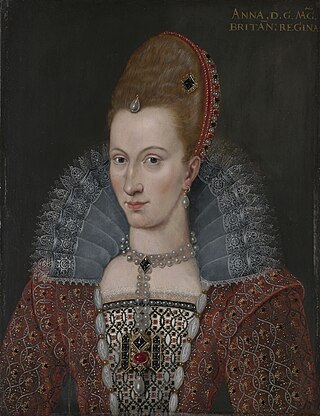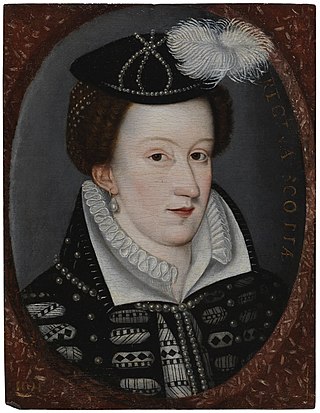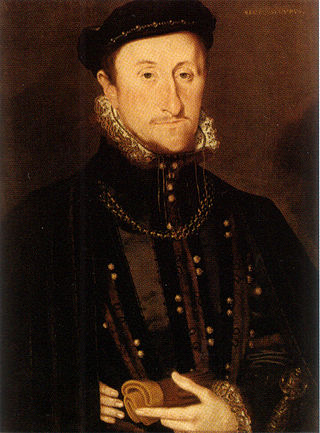Related Research Articles

George Heriot was a Scottish goldsmith and philanthropist. He is chiefly remembered today as the founder of George Heriot's School, a large independent school in Edinburgh; his name has also been given to Heriot-Watt University, as well as several streets in the same city.

George Home, 1st Earl of Dunbar, KG, PC was, in the last decade of his life, the most prominent and most influential Scotsman in England. His work lay in the King's Household and in the control of the State Affairs of Scotland and he was the King's chief Scottish advisor. With the full backing and trust of King James he travelled regularly from London to Edinburgh via Berwick-upon-Tweed.
William Schaw was Master of Works to James VI of Scotland for building castles and palaces, and is claimed to have been an important figure in the development of Freemasonry in Scotland.
George Heriot was a Scottish goldsmith and member of the Parliament of Scotland. He is perhaps best known as the father of the philanthropist George Heriot, his eldest son.
Jean Fleming, Countess of Cassilis (1553/4–1609) was a Scottish noblewoman and courtier at the court of James VI of Scotland, and a survivor of domestic violence.
Thomas Foulis was a Scottish goldsmith, mine entrepreneur, and royal financier.

On 17 May 1590, Anne of Denmark was crowned Queen of Scotland. There was also a ceremony of joyous entry into Edinburgh on 19 May, an opportunity for spectacle and theatre and allegorical tableaux promoting civic and national identities, similar in many respects to those performed in many other European towns. Celebrations for the arrival of Anne of Denmark in Scotland had been planned and prepared for September 1589, when it was expected she would sail from Denmark with the admirals Peder Munk and Henrik Gyldenstierne. She was delayed by accidents and poor weather and James VI of Scotland joined her in Norway in November. They returned to Scotland in May 1590.
Robert Jousie was a Scottish merchant, financier, and courtier.
Sir John Gordon of Lochinvar and Kenmure, was a Scottish courtier, landowner, and supporter of Mary, Queen of Scots.

Jacques de Bousie was a Flemish confectioner known as a "sugarman" working in Edinburgh, Scotland, employed by James VI and Anne of Denmark.

The jewels of Mary, Queen of Scots (1542–1587), are mainly known through the evidence of inventories held by the National Records of Scotland. She was bought jewels during her childhood in France, adding to those she inherited. She gave gifts of jewels to her friends and to reward diplomats. When she abdicated and went to England many of the jewels she left behind in Scotland were sold or pledged for loans, first by her enemies and later by her allies. Mary continued to buy new jewels, some from France, and use them to reward her supporters. In Scotland her remaining jewels were worn by her son James VI and his favourites.
Alexander Clark of Balbirnie was a Scottish merchant and Provost of Edinburgh. He was closely involved with English diplomacy.
Archibald Stewart was a Scottish merchant and Provost of Edinburgh.

Queen Elizabeth I of England paid a subsidy to King James VI of Scotland from 1586 to 1602. This enabled her to influence James by delaying or deferring payments to his diplomats in London. Records survive of the yearly amounts, and details of the expenditure in some years. A large proportion of the money was spent on the royal wardrobe of James and Anne of Denmark. Some royal expenses were met by Anne of Denmark's dowry, which was known as the "tocher".
William Fairlie or Fairley was an Edinburgh merchant and burgess.
Robert Abercromby was a Scottish leatherworker serving the Scottish monarchy in the 16th century.
Michael Gilbert was an Edinburgh goldsmith and financier.

Peter Sanderson was an Edinburgh tailor who worked for Anne of Denmark wife of James VI of Scotland.

James Barroun or Baron was a wealthy Scottish merchant based in Edinburgh and supporter of the Scottish Reformation.

Alexander Oustean or Oustian or Austin was a Scottish tailor and member of Edinburgh burgh council.
References
- ↑ Jean Munro & Henry Steuart Fotheringham, Edinburgh Goldsmith's Minutes (Edinburgh, 2006), p. 33: National Records of Scotland, GD103/2/105 a receipt to David Cunningham of Robertland for gold buttons, 10 November 1593, shows that John Cunningham identified himself both as a merchant burgess and goldsmith.
- ↑ Marguerite Wood, Extracts from the Records of the Burgh of Edinburgh: 1589-1603 (Edinburgh, 1927), p. 332 Edinburgh City Archives MS 'Bailies Accounts, Unlaws 1564–1664, pp. 285–289.
- ↑ Calendar of State Papers, Scotland, 1593–1595, vol. 11 (Edinburgh, 1936), no. 597.
- ↑ Winifred Coutts, The Business of the College of Justice in 1600 (Edinburgh: Stair Society, 2003), pp. 63–64, citing NRS CS7/190/27v.